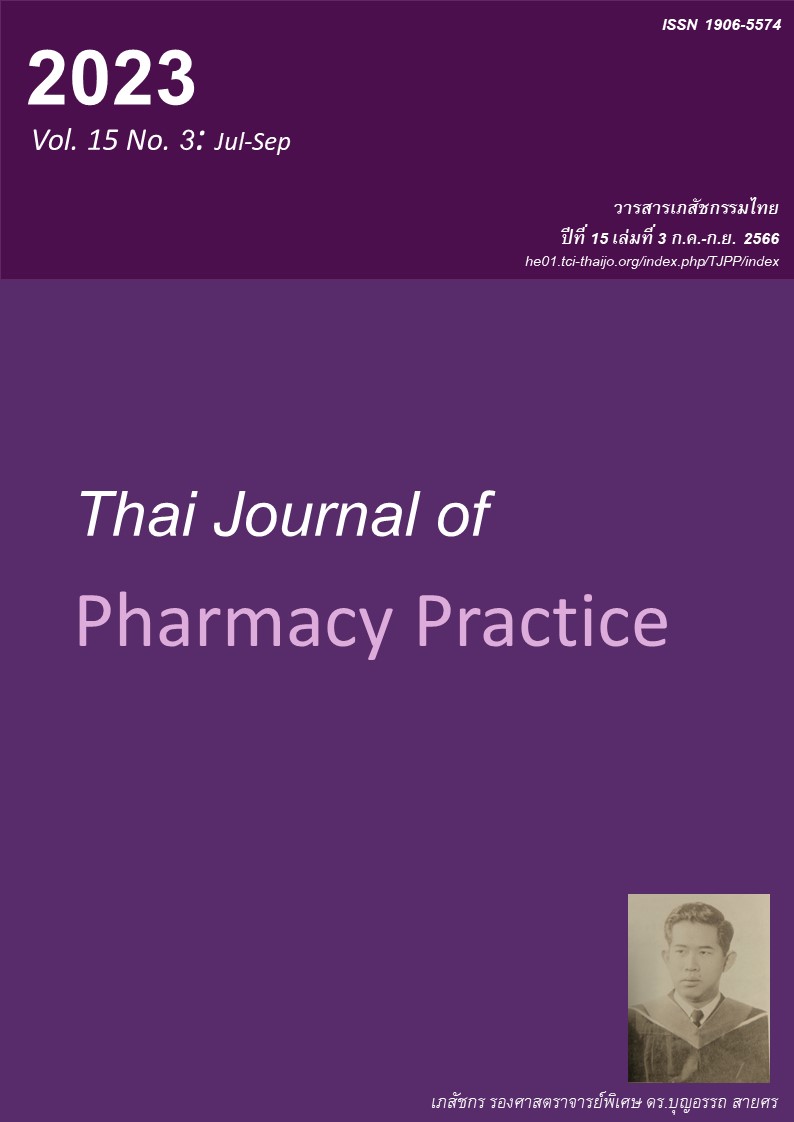ความชุกของเหตุการณ์ไม่พึงประสงค์จากการใช้เครื่องสำอางและปัจจัยที่มี ความสัมพันธ์ต่อพฤติกรรมการใช้เครื่องสำอางอย่างเหมาะสมในวัยรุ่น
Main Article Content
บทคัดย่อ
วัตถุประสงค์: เพื่อศึกษาความชุกของเหตุการณ์ไม่พึงประสงค์จากการใช้เครื่องสำอางในวัยรุ่น และปัจจัยที่มีความสัมพันธ์ต่อพฤติกรรมการใช้เครื่องสำอางอย่างเหมาะสมในวัยรุ่น วิธีการ: กลุ่มตัวอย่าง คือ วัยรุ่นที่มีอายุ 15-19 ปี ซึ่งกำลังศึกษาระดับมัธยมศึกษาตอนปลายหรือประกาศนียบัตรวิชาชีพ (ปวช.) จำนวน 419 คน ซึ่งเลือกมาแบบหลายขั้นตอน การศึกษาเก็บรวบรวมข้อมูลด้วยแบบสอบถามความรู้เกี่ยวกับการใช้เครื่องสำอางที่ถูกต้อง ทัศนคติ และพฤติกรรมการใช้เครื่องสำอางอย่างเหมาะสม การวิเคราะห์ปัจจัยที่มีความสัมพันธ์ต่อพฤติกรรมการใช้เครื่องสำอางอย่างเหมาะสมในวัยรุ่นใช้สถิติถดถอยพหุคูณโลจิสติกพหุตัวแปร โดยใช้ค่ามัธยฐานแบ่งกลุ่มพฤติกรรมการใช้เครื่องสำอางเป็นสองกลุ่ม ผลการวิจัย: ความชุกของตัวอย่างที่รายงานเหตุการณ์ไม่พึงประสงค์เท่ากับร้อยละ 73.29 ส่วนใหญ่เป็นเหตุการณ์ไม่พึงประสงค์ชนิดไม่รุนแรง (ร้อยละ 87.36) อาการที่พบมากที่สุด คือ ผื่น (ร้อยละ 37.78) คัน (ร้อยละ 13.78) และผิวลอก (ร้อยละ 12.44) การศึกษาในระดับ ปวช. 1-3 (AOR = 0.36, 95%CI; 0.20-0.66) และการมีเพื่อนที่มีอิทธิพลต่อการเลือกซื้อเครื่องสำอาง (AOR = 0.33, 95%CI; 0.15-0.71) และทัศนคติการใช้เครื่องสำอางอย่างเหมาะสมในระดับสูง (AOR = 2.78, 95%CI; 1.14-6.80) มีความสัมพันธ์ต่อพฤติกรรมการใช้เครื่องสำอางอย่างเหมาะสมอย่างมีนัยสำคัญทางสถิติ สรุป: ความชุกของเหตุการณ์ไม่พึงประสงค์จากการใช้เครื่องสำอางในวัยรุ่น อยู่ในระดับสูง แต่เป็นเหตุการณ์ไม่พึงประสงค์ชนิดไม่รุนแรง การศึกษาระดับ ปวช. 1-3 การมีเพื่อนมีอิทธิพลต่อการใช้เครื่องสำอางอย่างเหมาะสม และการมีระดับทัศนคติการใช้เครื่องสำอางอย่างเหมาะสมในระดับสูงมีความสัมพันธ์ต่อพฤติกรรมการใช้เครื่องสำอางอย่างเหมาะสม ดังนั้น หน่วยงานทางสุขภาพและที่เกี่ยวข้องควรมีการเฝ้าระวังความปลอดภัยในการใช้เครื่องสำอางในวัยรุ่นอย่างต่อเนื่อง และควรจัดกิจกรรมส่งเสริมทัศนคติในการใช้เครื่องสำอางที่ถูกต้อง โดยเฉพาะในกลุ่มวัยรุ่นกลุ่มที่กำลังศึกษาในระดับ ปวช. 1-3
Article Details

อนุญาตภายใต้เงื่อนไข Creative Commons Attribution-NonCommercial-NoDerivatives 4.0 International License.
ผลการวิจัยและความคิดเห็นที่ปรากฏในบทความถือเป็นความคิดเห็นและอยู่ในความรับผิดชอบของผู้นิพนธ์ มิใช่ความเห็นหรือความรับผิดชอบของกองบรรณาธิการ หรือคณะเภสัชศาสตร์ มหาวิทยาลัยสงขลานครินทร์ ทั้งนี้ไม่รวมความผิดพลาดอันเกิดจากการพิมพ์ บทความที่ได้รับการเผยแพร่โดยวารสารเภสัชกรรมไทยถือเป็นสิทธิ์ของวารสารฯ
เอกสารอ้างอิง
Tongsang T, Chaimay B, Woradet S. Prevalence of cosmetic adverse events: A systematic review. [on line]. 2022 [cited Jul 29, 2022]. Available from: sc. sci.tsu.ac.th/tsucon32/downloads/Proceeding.pdf
Phatthalung Provincial Public Health Office. Processing of complaints about Gluta White Lotion: Report on the study of Gluta white lotion. Phattha- lung: Phatthalung Provincial Public Health Office; 2014.
Phatthalung Provincial Public Health Office. Processing of complaints about White Shadow Super Whitening Cream: Report on the study of White Shadow Super Whitening Cream. Phattha- lung: Phatthalung Provincial Public Health Office; 2020.
Kongwong R, Wattananamkul V. A Study of “harmful cosmetics” usage behavior among female teenagers in Ubon ratchathani province. Isan Journal of Pharmaceutical Sciences 2011; 7: 76-87.
Shrestha R, Shakya J. Knowledge regarding adverse effects of selected cosmetic products among higher secondary level girl students, Chitwan. Journal of Chitwan Medical College 2016; 6: 27–32.
World Health Organization. Adolescent health [online]. 2015 [cited May 1, 2021]. Available from: www.who.int/southeastasia/health-topics/adolescen t-health.
Freud S. The origin and development of psycho analysis Am J Psychol 1910; 21: 181–218.
Erikson EH. Identity: youth and crisis. Oxford, England: Norton & Co.; 1968.
Bandura A. Social learning theory. Oxford, England: Prentice-Hall; 1977.
TaWai for Health. Report on health product problems. Phatthalung: Phatthalung Provincial Public Health Office; 2021.
Bloom BS. Taxonomy of educational objectives. New York: Longmans, Green; 1964.
Watcharananathavisan P. Factors related to the detection of pharmaceutical substances adulterated in food products claiming to reduce weight or sexual enhancement [master thesis]. Nakorn Pathom: Silpakorn University; 2020.
Department of Provincial Administration. Population statistics from the civil registration [online]. 2021 [cited May 7, 2021]. Available from: stat.bora.dopa. go.th/stat/statnew/statMONTH/statmonth/#/view.
Ngamjarus C, Chongsuvivatwong V, McNeil E. n4 Studies: Sample size calculation for an epidemio logical study on a smart device. Siriraj Medical Journal 2016; 68: 160–70.
Nitiyarom R, Banomyong N, Wisuthsarewong W. Knowledge about, attitude toward, and practices in skin care among Thai adolescents. J Cosmet Dermatol 2022; 21: 1539–46.
Phatthalung Provincial Public Health Office. Report of the results of health product analysis. Phattha lung: Phatthalung Provincial Public Health Office; 2020.
Phatthalung Provincial Public Health Office. Summary of the case of taking the Lynn dietary supplement brand and products that are produced and sold by Magic Skin Company. Phatthalung: Phatthalung Provincial Public Health Office; 2018.
Food and Drug Administration. Guidelines for managing disasters from health products [online]. 2016 [cited May 1, 2021]. Available from: thaihpvc. fda.moph.go.th/thaihvc/Public/NewsAdr/uploads/hpvc_747.pdf.


